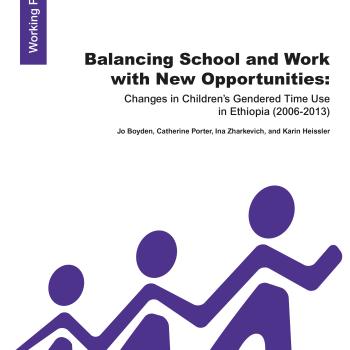
This paper explores changes in how boys and girls in Ethiopia spend their time, with a particular focus on work and schooling. We compare boys and girls aged 12 in 2006 with another group of the same age, surveyed seven years later, in 2013. Ethiopia is the poorest country in the Young Lives study and its mainly rural population has long depended on children’s work to overcome difficult economic conditions. We speak to two policy concerns, first that there is a gender bias in how children spend their time, and second, that work by children undermines their education. The Government of Ethiopia has passed legislation stopping work that harms children’s education and stating 14 as the minimum age for employment, and there are several initiatives focused on keeping girls in school.
The survey data show that overall there is a small reduction in the hours 12-year-olds spend in paid or unpaid work (outside or inside the household) over the seven-year period. However, this downward trend holds mainly in urban areas, where both boys and girls spend much less time on work than they did seven years previous. While rural children all work longer hours than urban children, rural girls did see a decline in hours worked over time. However, rural boys have increased their working hours slightly, and by 2013 were working longer hours than girls.
Overall, our analysis does not support the policy assumption that weak education outcomes are due to low demand from parents, since both parents and children state their wish for the children to reach high levels of education. However, this positive outlook is sometimes tempered by adverse experiences at school. Our findings challenge the perception that girls are consistently disadvantaged in relation to boys in school access and work burden. In-depth interviews in two rural communities reveal that a rise in work opportunities means not only that work remains an attractive and viable alternative to education, but that, contrary to expectations, the increased returns to work have lowered boys’ education aspirations and increased their school drop-out rates relative to girls’.

This paper explores changes in how boys and girls in Ethiopia spend their time, with a particular focus on work and schooling. We compare boys and girls aged 12 in 2006 with another group of the same age, surveyed seven years later, in 2013. Ethiopia is the poorest country in the Young Lives study and its mainly rural population has long depended on children’s work to overcome difficult economic conditions. We speak to two policy concerns, first that there is a gender bias in how children spend their time, and second, that work by children undermines their education. The Government of Ethiopia has passed legislation stopping work that harms children’s education and stating 14 as the minimum age for employment, and there are several initiatives focused on keeping girls in school.
The survey data show that overall there is a small reduction in the hours 12-year-olds spend in paid or unpaid work (outside or inside the household) over the seven-year period. However, this downward trend holds mainly in urban areas, where both boys and girls spend much less time on work than they did seven years previous. While rural children all work longer hours than urban children, rural girls did see a decline in hours worked over time. However, rural boys have increased their working hours slightly, and by 2013 were working longer hours than girls.
Overall, our analysis does not support the policy assumption that weak education outcomes are due to low demand from parents, since both parents and children state their wish for the children to reach high levels of education. However, this positive outlook is sometimes tempered by adverse experiences at school. Our findings challenge the perception that girls are consistently disadvantaged in relation to boys in school access and work burden. In-depth interviews in two rural communities reveal that a rise in work opportunities means not only that work remains an attractive and viable alternative to education, but that, contrary to expectations, the increased returns to work have lowered boys’ education aspirations and increased their school drop-out rates relative to girls’.

